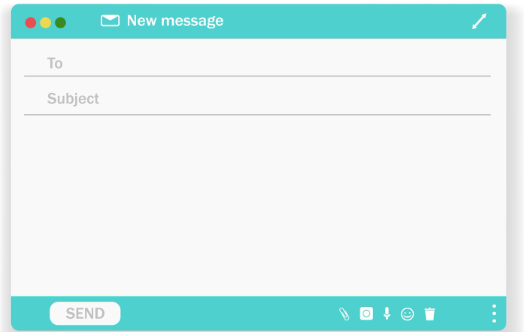Whether you’re applying for a new role, contacting a headteacher overseas, or following up with a colleague, the way you write your emails says a lot about you. For many teachers working internationally, email is the first and most frequent form of communication; it’s usually how you connect with schools, recruiters and even parents.
But writing professional, effective emails isn’t always as simple as it sounds. Even with all the AI tools we have at our disposal nowadays, it is still an essential skill every working professional must have. It’s easy to think “I write so many emails every day, I already know what I’m doing”, but what some people fail to take into consideration is that different cultures, communication styles and expectations can easily lead to misunderstandings if you’re not careful.
That’s why we’re here to discuss email etiquette today. In this article we’ll share some small but powerful habits that will help you make the right impression and build stronger professional relationships.

What is email etiquette (and why does it matter for teachers and schools)?
Email etiquette is all about writing with clarity and professionalism, all whilst being polite. Contrary to what some may think, it’s not about being overly formal, but it’s about knowing how to communicate in a way that’s polite, clear and culturally sensitive.
Here’s why it’s especially important in international education:
- First impressions count. Before you even step into an interview, your email has already spoken for you. Do you think schools will want to proceed with an application from a candidate whose email had lots of mistakes or who came across as rude? Always keep this in mind.
- You represent yourself (and your school). Professional communication reflects your attention to detail and respect for others.
- It prevents misunderstandings. Language barriers and cultural differences can easily cause confusion, especially when communicating with people who aren’t from your home country. A well-written message helps bridge that gap.
- It builds trust and respect. Thoughtful, courteous emails make working relationships smoother, whether it be with admin teams, colleagues or leadership.
Finding the right tone
The best emails require a balance when it comes to tone: friendly, respectful, and professional. It can be a little tricky sometimes. If you’re too formal, you run the risk of sounding distant. Too casual, and it might come across as careless.
Here are a few quick tips to help you out:
- Match the tone. If someone signs off with “Kind regards,” reply in a similar manner. If they’re more casual, you can start with a “Hi Jamie”. Just make sure not to cross the line into “Hey!” unless you know them well enough.
- Keep it positive and solution-focused. Instead of “I can’t attend,” try “Would it be possible to reschedule?”
- Avoid sarcasm or humour. What’s funny in one country can be confusing in another.
Example:
❌ “Hey! You finally replied 😅”
✅ “Thanks so much for getting back to me – really appreciate your time.”
Structuring your email clearly
A well-structured email is easier to understand and saves the reader time. Let’s go step by step.

1. Subject line: Short and specific.
- ‘Year 5 English Lesson Plan Submission’
- ‘Follow-Up: Interview Availability’
2. Greeting: Use the right name and title.
- “Dear Mr. Singh,” or “Hello Miss Peters,”
- Make sure to double-check spellings. Getting a name wrong is a small mistake that makes a big impact!
3. Body: Keep it clear and organised. One main point per paragraph.
4. Call to action: End with a clear next step.
- “Please confirm by Friday if that time suits you.”
5. Sign off: Choose something simple and polite.
- “Kind regards,”
- “Best wishes,”
- “Warm regards,”
Common mistakes to avoid
Even the most experienced professionals slip up from time to time. Here are a few habits worth checking before you hit send:
- Writing way more than you need to. Keep it concise.
- Forgetting to proofread. Even if you’re in a rush, always check grammar, punctuation and spelling.
- Leaving off attachments (or sending the wrong one!).
- Using ALL CAPS – it reads like shouting.
- Forgetting to delete AI response lines such as “Here is a polished response…”.

- Adding too many exclamation marks!!! Or question marks???
- Using slang, text abbreviations or emojis in formal emails.
- Misusing CC or BCC. A very easy mistake to make, but it’s super important to respect people’s privacy.
- Forgetting your signature. Make sure it includes your name, job title and school.
- Emailing in anger. We get it – sometimes you don’t get the response you were after. Maybe the person you are emailing is failing to understand you or something outside of work has affected your mood too. Regardless of how you feel, your anger should not come across in the way you communicate (not just in an email, but in any professional situation). If an email has upset you, write your response in a draft, take a break, and come back later. You’ll almost always rephrase it more calmly the second time around.

Responding professionally
Replying to emails is just as important as sending them. The way you handle communication reflects your reliability and professionalism.
- Acknowledge quickly. Aim to respond within 24-48 hours, even if it’s just a short note saying you’ll reply properly soon.
- Never “ghost.” If you’re waiting for information or need time, let the sender know. If you are unable to respond in the moment, make a note of it somewhere or mark the email as ‘unread’ so you know to come back to it ASAP.
- Stay calm in tricky situations. If a message frustrates you, take a breath before replying.
- Remember, the international education world is smaller than you think. That admin assistant you’re rude with today might be the HR manager interviewing you next year or might know someone in leadership.
Example:
❌ “That’s not my job.”
✅ “Thanks for getting in touch! I believe this might be something the admin team handles, but I’m happy to assist if needed.”
Following up (without being pushy)
We’ve all been there – you’ve sent an important email, and days pass with no reply. Following up is perfectly fine; it just needs to be done politely.
- Wait 2–3 business days before following up, unless it’s urgent.
- Be gentle. Try something like: “Just checking in on my previous email regarding…”
- Assume the best. Most people are simply busy, a kind nudge usually does the trick.
Example:
✅ “I hope you’re well. I just wanted to follow up on my email from Tuesday about the new timetable. Please let me know if you need any more details from me.”
Writing the perfect email
Good email etiquette isn’t about sounding robotic, it’s about showing respect, clarity, and professionalism in how you communicate.

In a world where your message might cross multiple time zones and cultures, the effort you put into writing thoughtfully really does make a difference. Whether you’re a teacher, a recruiter, or a school leader, polished email habits help you stand out for all the right reasons.
So next time you open your inbox, remember:
Be polite. Be clear. Be human.




